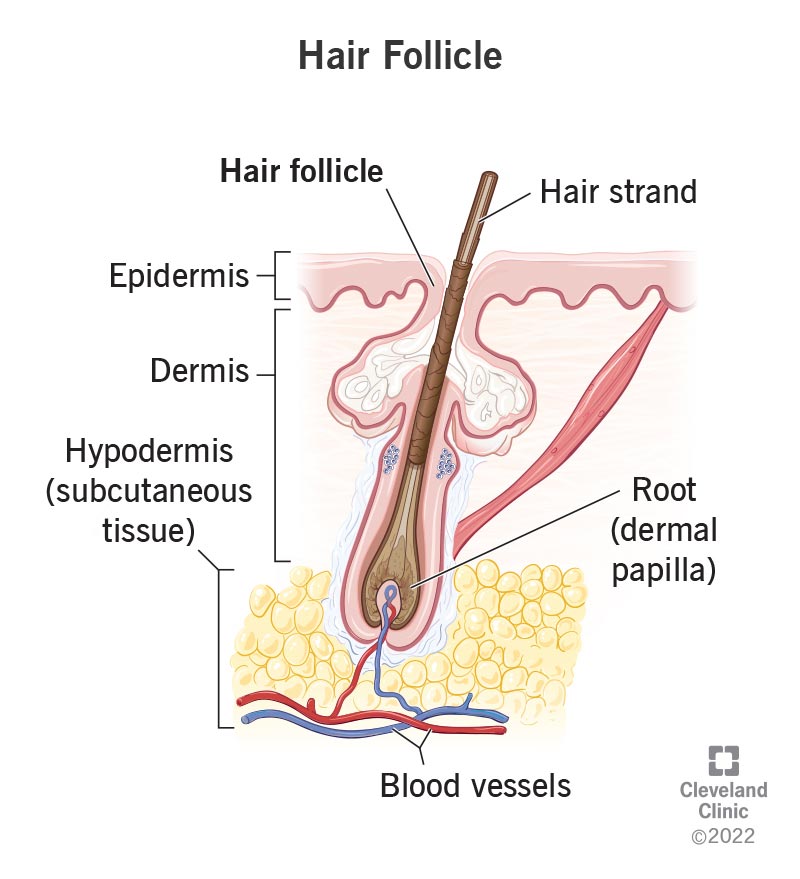Hair follicles are structures within your skin that grow your hair. You’re born with millions of hair follicles in your skin. You can’t pull out hair follicles. Damaged hair follicles lead to hair loss or reduced hair growth.
Advertisement
Cleveland Clinic is a non-profit academic medical center. Advertising on our site helps support our mission. We do not endorse non-Cleveland Clinic products or services. Policy

A hair follicle is a tube-like structure (pore) that surrounds the root and strand of a hair. Hair follicles exist in the top two layers of your skin. You’re born with over 5 million hair follicles in your body and over one million hair follicles on your head. As you age, hair grows out of your hair follicles.
Advertisement
Cleveland Clinic is a non-profit academic medical center. Advertising on our site helps support our mission. We do not endorse non-Cleveland Clinic products or services. Policy
Your hair follicle is one of a few structures in your body that can stop functioning and begin functioning again (degenerate and regenerate). This process helps with hair growth on your body.
The function of a hair follicle is to grow your hair. In addition to promoting hair growth, your hair follicles do the following jobs:
The cells in your hair follicles help your body heal after a wound. When your body receives an injury, the cells within your hair follicles are closest to the wound and quickly move to the site of the wound to start the healing process. Your hair follicle cells assist your body’s white blood cells in your immune system.
Hair grows in cycles within your hair follicle:
Advertisement
Wherever you have hair on your body, you also have hair follicles. Hair follicles originate in the first and second layers of your skin (epidermis and dermis). Follicles holding your terminal hair, or the hair that grows on your scalp, eyelashes and eyebrows, extend into the first and second layer of your skin and sometimes into the third layer (subcutaneous tissue).
A hair follicle looks like a long tube that holds your hair. It’s in the shape of a cylinder with a rounded bottom in your skin. The top of the cylinder is an open hole, which is where your hair grows out. Your follicle is similar to a sock; your hair is your foot that goes into your sock.
You can’t pull out a hair follicle, as it’s the structure within your skin that holds your hair. If you pull out a strand of hair, you might notice a bulb or round ball (root) attached to the end of the hair strand. The root is surrounded by nerve fibers that let you feel when your hair moves or you touch your hair. Removing this root doesn’t mean your hair won’t grow back, because in most cases, it will.
While your hair color can change throughout your life, your hair follicle, which is part of your skin, is the same color as your natural skin tone. The color of your hair follicle doesn’t relate to the color of your hair.
The size of each hair follicle in your body is different based on the size of the cells that make up the base of the structure. Hair follicles are microscopic and you can’t see them simply by looking at your skin.
Your hair follicle is made up of layers of cells within layers of your skin. These cells create a tube-like structure to hold your hair.
Several conditions affect the health of your hair follicles. The most common conditions include:
Symptoms vary for each condition and could include:
Each condition requires different tests to make a diagnosis. Your healthcare provider will physically examine your skin and hair and ask questions about your medical history before running a test that could include:
Advertisement
Treatment is unique to each person based on their symptoms and could include:
You can keep your hair follicles healthy and strong by taking care of your hair and your skin. You can do this by:
If you damage your hair follicles after an injury, they can repair themselves and your hair will grow back. It could take up to four years before you see new hair growth out of damaged hair follicles, depending on the severity of your injury. Frequent injuries to your skin and hair follicles can produce scars, which make growing hair difficult. Hair that does grow is thinner and more fragile hair than normal. This can lead to hair loss at the site of your injured skin.
Advertisement
Hair follicles are part of your skin that are responsible for growing your hair. If you accidentally pull out a strand of your hair and it has a ball (bulb) on the end of it, you didn’t pull out the follicle, and instead, you removed your hair root. That root grows back and your hair will grow back, too. If you notice you’re not growing hair in an area that you used to grow hair, talk to your healthcare provider.
Advertisement
Losing your hair can be shocking and overwhelming. At Cleveland Clinic, we’ll find the right treatment to help you feel (and look) like yourself again.

Last reviewed on 07/08/2022.
Learn more about the Health Library and our editorial process.